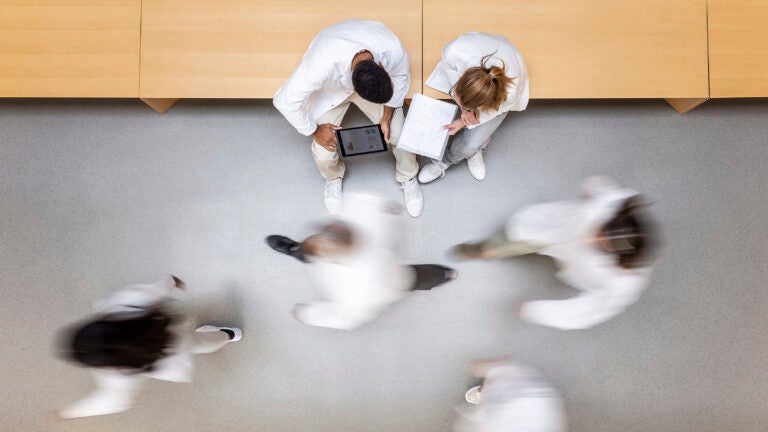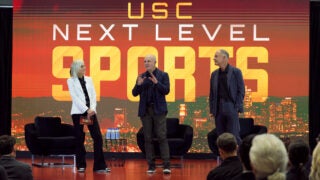
The annual NEMO Prize supports collaborations between researchers at the USC Viterbi School of Engineering and the university’s constellation of health sciences schools. (Photo/iStock)
Research teams awarded NEMO Prizes for work at the intersection of health, engineering
Funded by a gift from Shelly and Ofer Nemirovsky, the latest prizes address a rare childhood heart disease and a widespread cause of blindness.
An artificial right heart atrium that could save the lives of children with a rare disease. An AI-powered method to prevent blindness from glaucoma. These are early-stage innovations that were awarded the NEMO Prize through USC’s Office of Health Affairs.
Launched in 2023 through a gift from Shelly and Ofer Nemirovsky, the annual NEMO Prize competition supports collaborations between researchers at the USC Viterbi School of Engineering and the university’s constellation of health sciences schools. In particular, this prize focuses on projects that do not yet qualify for support by federal agencies and are not yet mature enough for private investment.
“A lot of things get funded by the National Institutes of Health when they already know it’s going to work,” said Shelly Nemirovsky, a USC trustee and 1985 graduate of the university. “But I think if you get in at the early stages of research and you gain some traction, you can really move the needle.”
“I love the technology that we’ve seen,” added Ofer Nemirovsky, who has a business and engineering degree from the University of Pennsylvania, where he started the original NEMO Prize. “These proposals represent solutions for both ailments that affect a very specific number of people and broader conditions that affect many more people.”
Each prize-winning partnership exemplifies a multidisciplinary effort to tackle a complex medical issue with creative thinking and execution from experts in the engineering, science, medical and computer science fields.
To help prevent blindness, the ATLAS (AI + Teleophthalmology in Los Angeles) Initiative collaborators Benjamin Xu, chief of the glaucoma division and associate professor of clinical ophthalmology at the USC Roski Eye Institute; Carl Kesselman, the William M. Keck Professor of Engineering in the Epstein Department of Industrial and Systems Engineering and director of the Informatics Systems Research Division at the USC Information Sciences Institute; and Jose-Luis Ambite, an associate research professor of computer science at USC Viterbi, partnered with Lauren Daskivich, director of ophthalmic services and eye health programs for the L.A. County Department of Health Services, to use artificial intelligence to develop a more efficient system to detect glaucoma.
To tackle a rare, life-threatening heart defect, Aerospace and Mechanical Engineering Associate Professor Niema Pahlevan of USC Viterbi; Andrew Cheng, an associate professor of clinical pediatrics at the Keck School of Medicine of USC; and cardiac surgeon Cynthia Herrington, the Ryan Winston Family Chair in Transplant Cardiology at Children’s Hospital Los Angeles, teamed up to design an innovative device that could give young patients their best chances at survival.
Using artificial intelligence to diagnose glaucoma
When researchers Kesselman, Xu, Ambite and Daskivich joined forces for the ATLAS project, they first had to learn how to speak the same language. “With multidisciplinary collaboration, it’s not about sticking a bunch of people in the room,” said Kesselman, a William M. Keck Professor of Engineering at USC Viterbi. “It’s about learning culture. It’s about learning the way a computer scientist looks at this problem and the way an engineer looks at this problem and coming to a level of understanding.”

With the NEMO Prize and other support and funding from USC, the ATLAS project is combining disparate disciplines for the shared goal of an innovative solution to diagnosing and treating a common ailment.
Glaucoma is the leading cause of irreversible blindness worldwide — it’s also one of the major drivers of preventable blindness, Xu said. Unfortunately, glaucoma detection usually requires specialized equipment and the expertise of a trained ophthalmologist or optometrist — and they’re in limited and decreasing supply. An aging population and an increase in the prevalence of glaucoma has also led to a growing demand for better methods of detection, especially in underserved populations. As a result, the team says more than half of glaucoma cases in the United States go undetected and untreated.
An innovative solution for a common problem
Ophthalmologists can use a fundus camera to examine the back of the eye when screening for eye diseases such as glaucoma. Because fundus photography of the retina is considered the standard of care for diabetes patients, the ATLAS team leveraged the large volume of eye images from Daskivich’s L.A. County diabetic retinopathy screening program. With the addition of eye images from the USC Roski Eye Institute, the ATLAS team had access to a robust dataset to address the central question of their project: How do you harness artificial intelligence to identify the growing number of people who are likely to have glaucoma and connect them with a limited number of specialists for diagnosis and treatment?
“There’s a high degree of variability in glaucoma screenings, and you need considerable skill to do this,” said Daskivich, who emphasized the limited number of ophthalmologists available to patients. “So, the question became: Can you actually create AI algorithms that will look at these pictures and make a recommendation as to whether somebody should come in and get looked at in more detail?”
The way forward came in 2022, in the form of a collaboration that leveraged Xu’s clinical knowledge of glaucoma, Ambite’s expertise in leading-edge AI technology, Daskivich’s expertise in healthcare implementation and Kesselman’s computing platform that allows the team to organize its huge dataset.
“This is a real team effort in that each member of the ATLAS Initiative brings a different domain of expertise,” Xu said. “It required getting many people in the same room who don’t normally talk to each other. This is a huge barrier to implementation science that we’ve been able to overcome with this multidisciplinary group.”
With support from the NEMO Prize and future funding, the team hopes to evaluate algorithm effectiveness and equity; demonstrate the feasibility of integrating AI algorithms into existing screening workflows; and develop multimodal AI algorithms that can detect glaucoma while accounting for multiple factors such as age, race and family history.
A rare opportunity to save young lives
Pahlevan and Cheng met each other earlier in their careers at Caltech in Pasadena. A joint research project directed their attention to young patients who had received the Fontan procedure, a palliative surgery for hypoplastic left heart syndrome, a rare and life-threatening congenital defect where the left side of the heart is underdeveloped. With this surgery, young patients can function with only one ventricle of the heart, instead of two. Unfortunately, that single-ventricle circulation eventually fails, leaving the patient in need of a heart transplant.

A colleague at CHLA connected Pahlevan and Cheng with Herrington, who was seeking a collaboration with engineers and mechanicians to create an artificial right atrium (ARA) to improve mechanical circulatory support for patients with failing Fontan circulation. Nine years into this collaboration, the trio is closer than ever to developing an ARA that could transform the lives of their young patients — with help from the NEMO Prize.
The Fontan surgery was first proposed by surgeons in 1968; by the 1990s, practitioners considered the procedure a routine line of treatment for young patients with single-valve heart defects, giving many children the opportunity to reach adulthood. Due to advancements to the Fontan procedure and improvements in peri- and post-operative care, the team projects that the population of patients with Fontan circulation will double in the next 20 years.
Despite these advances, most Fontan patients will eventually experience myriad health challenges as the circulation begins to fail, including issues with the brain, kidneys, liver, lungs and lymphatic system. Without a heart transplant — a solution where demand far exceeds supply — Fontan patients face a progressively higher risk of heart failure and premature death.
Typically, ventricular assist devices (VADs) are used for heart failure patients, who number roughly 26 million worldwide, allowing them to survive in the hopes of an eventual heart transplant. For the 70,000 people around the world living with the inevitable decline in Fontan circulation, VADs are rarely an option due to their unique heart anatomy — but an ARA could change that.
According to the team, no other group of researchers and engineers has successfully tried to create an ARA. Others have attempted to build a customized VAD from scratch, which Cheng said takes far too much time to be a practical solution. By creating an ARA device that hospitals can use to augment existing VADs, Cheng, Herrington and Pahlevan seek to decrease the time it takes for their product to have real-life implications for their young patients hoping to live long enough to receive a heart transplant.
The team says the NEMO Prize funding will be instrumental in helping them finalize the design of their device and move toward production and testing with conventional VADs.
For Pahlevan, the project represents an opportunity he didn’t think he would experience in his field of study. “It’s rare for engineers to be in the position to make a real contribution to patient well-being,” he said. “For me, that was very important.”
For Cheng, this project is impactful on two fronts. As an electrical engineering major who decided to go to medical school, he has always wanted the opportunity to solve a medical problem with an engineering lens. “From another perspective, these families are patients that I take care of all the time,” said Cheng, who is the director of CHLA’s Fontan clinic. “To be able to offer something tangible to them that will greatly increase the likelihood of a good outcome is really important to me.”
“Winning the NEMO Prize makes all the difference in the world at a very pivotal point in this device’s creation,” Herrington said. “My colleagues in the transplant world are excited that this thing could be hitting the shelf sometime in their career and lifetime. I can’t thank the team from NEMO enough.”
For the Nemirovskys, their support for collaborations like ARA and ATLAS is endlessly rewarding.
“I am so excited to see what next year’s slate holds, because I feel like since the first prize launched, and the word has gotten out there, we’ve received more applicants, more stories, more everything,” Shelly Nemirovsky said. “The potential is limitless.”
The Request for Applications for this year’s NEMO Prize will be released in March.



